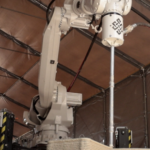In a new paper published, researchers from the Technical University of Denmark have demonstrated two cutting-edge repair methods for Continuous Fiber Composite (CFC) structures. The focus of the investigation was on repairing Continuous Fiber Reinforced Thermoplastic (CFRTP) specimens, employing automated print in-situ repair and adhesive patch repair methods.
Benefits of In-situ Repair
A key advantage of CFRTP 3D printing for composite part repair is its in-situ capability, enabling repairs directly on the damaged part without the need for relocation. This not only saves time and costs but also minimizes operational disruptions. Additionally, the method excels in repairing parts with intricate geometries and internal structures, ensuring adaptability to complex shapes.

The use of CFC printing for structural repairs results in mechanical properties closely resembling the original composite structure. This is particularly advantageous for the repair of high-performance load-bearing structures. Moreover, CFC 3D printing facilitates higher precision and enhanced control over the repair process, ensuring accuracy and consistency.
The utilization of the exact required material for the repair reduces material waste, presenting a more sustainable solution. The approach appears to be a time-efficient, cost-effective, and sustainable method for repairing CFC structures, demonstrating improved performance and extended lifetime.
Methodology
The specimens were printed on an Anisoprint FDM machine, which deposits continuous fiber into a thermoplastic matrix. The study delved into the mechanical performance of the repaired specimens through meticulous tensile testing, a crucial aspect in evaluating the success of repair techniques.
An Instron universal testing machine facilitated the assessments with a 250 kN load cell, maintaining a consistent crosshead speed of 2 mm/min. Strain measurements were executed using two 6 mm long single clip gauges strategically placed on each side of the specimen.
Simultaneously, microstructure investigations provided valuable insights into the structural intricacies of 3D printed composite specimens. Micrographs of cross-sections and side sections revealed a layered-type microstructure, emphasizing the distinct boundaries between the polycarbonate matrix and carbon fiber layers.
Results
The results yielded crucial insights, affirming the success of the proposed repair methods. Both adhesive patch and print in-situ repairs demonstrated the capability to restore the original stiffness and strength of damaged specimens to a high degree.

Notably, the elastic modulus of damaged specimens saw remarkable improvements of 30% and 44% through adhesive patch and print in-situ repairs, respectively. The corresponding strength enhancements were substantial at 20% and 28%.
Toughness, a critical metric for material resilience, saw increases of 31% and 36% for adhesive patches and print in-situ repairs in damaged specimens.
Additionally, the analytical model developed by the researchers was able to predict the elastic modulus aligned closely with experimental measurements, affirming its reliability as a predictive tool.
Future Implications
Automated print in-situ repair emerged as the standout performer, surpassing adhesive patch repair in terms of mechanical performance and reliability. Beyond its ability to restore original properties, the automated method carries significant implications for predicting the remaining lifetime of repaired composite structures accurately.
This could potentially lead to a reduction in design safety factors and associated costs, opening new avenues for industries relying on advanced composite materials.
You can read the full (pre-proof) research paper, titled “In-situ and adhesive repair of continuous fiber composites using 3D printing” in the Additive Manufacturing journal, at this link.
Come and let us know your thoughts on our Facebook, X, and LinkedIn pages, and don’t forget to sign up for our weekly additive manufacturing newsletter to get all the latest stories delivered right to your inbox.









